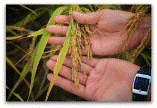Plant Pathology, Department of

Fungal Molecular Plant-Microbe Interactions
Date of this Version
12-2010
Document Type
Article
Citation
Proceedings of the National Academy of Sciences USA (December 14, 2010) 107(50): 21,902–21,907
doi: 10.1073/pnas.1006839107
Abstract
To cause rice blast disease, the fungus Magnaporthe oryzae breaches the tough outer cuticle of the rice leaf by using specialized infection structures called appressoria. These cells allow the fungus to invade the host plant and proliferate rapidly within leaf tissue. Here, we show that a unique NADPH-dependent genetic switch regulates plant infection in response to the changing nutritional and redox conditions encountered by the pathogen. The biosynthetic enzyme trehalose-6-phosphate synthase (Tps1) integrates control of glucose-6-phosphate metabolism and nitrogen source utilization by regulating the oxidative pentose phosphate pathway, the generation of NADPH, and the activity of nitrate reductase. We report that Tps1 directly binds to NADPH and, thereby, regulates a set of related transcriptional corepressors, comprising three proteins, Nmr1, Nmr2, and Nmr3, which can each bind NADP. Targeted deletion of any of the Nmr-encoding genes partially suppresses the nonpathogenic phenotype of a Δtps1 mutant. Tps1-dependentNmr corepressors control the expression of a set of virulence-associated genes that are derepressed during appressorium-mediated plant infection. When considered together, these results suggest that initiation of rice blast disease by M. oryzae requires a regulatory mechanism involving an NADPH sensor protein, Tps1, a set of NADP-dependent transcriptional corepressors, and the nonconsuming interconversion ofNADPHandNADPacting as signal transducer.


Comments
Copyright 2010, PNAS. Used by permission. http://www.pnas.org/cgi/doi/10.1073/pnas.1006839107